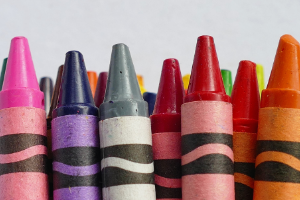The word ‘Crayons’ word sparks fond memories of our childhood and the colourful, imaginative masterpieces we all created. Crayons are one of the few creative tools that we all have used at some point in our lives, regardless of culture or geography. These timeless classics have inspired countless children to discover their artistic side while they explore, discover, play, learn, and dream.
You would be familiar with the classic green and yellow Crayola crayon boxes, as they are universally recognised by all and loved by children and adults alike. In 1828, Joseph Lemercier was the first to create a crayon suitable for children by replacing the oil normally found in crayons with wax. CRAYOLA was founded in 1902 by Edwin Binney and C. Harold Smith, who combined the French term for chalk (craie) with the term ‘ole’ from the word oleaginous (the paraffin wax used in crayons). At that time, Crayola only made 30 distinct colours of crayons and sold 19 different boxes.
In 2020, Crayola launched their most inclusive product line called ‘Colours of the World’, a box of varied skin-tone-inspired crayons in an effort to create a more inclusive environment for children. The ‘Colours of the World’ set includes 24 new hues that have been specifically designed to represent 40 global skin tones. These amazing and inspiring crayons were tested on real individuals and it took around three months to finalise the colour palette.
15 Fun and Colourful Crayon Facts:
1. Crayola produces 3 billion crayons a year
2. The most popular crayon box around the world is the 24-count box
3. Each box of crayon has three languages on them and they are English, Spanish, and French
4. The smell of crayons is the 18th most familiar scent for adults in the USA
5. Crayola helped introduce a new shade of blue to the world
6. The average child spends about 30 minutes each day colouring
7. In 1962 Crayola changed the name of their “Flesh” crayon to “Peach”
8. For their first 40 years in business Crayola employees had to hand roll the labels
9. American Gothic artist Grant Wood entered a Crayola sponsored drawing competition and came in third place, he later credited this win for encouraging him to stick with his art career
10. Emerson Moser, who worked for Crayola for 35 years was colour blind
11. Leftover crayons are called “Leftolas”
12. The average child wears down 720 crayons by the age of 10
13. Red and blue are the two most popular crayon colours
14. The world’s largest crayon is 15 feet high, 16 inches wide, 500 pounds, and blue (the favourite crayon colour)
15. 223 billion Crayola crayons have been produced to date
There’s nothing more inspiring and exciting than opening a brand new box of crayons. So, take a break from your busy routine and allow yourself to enjoy some mindful colouring once again, or introduce your children to colouring with crayons.

